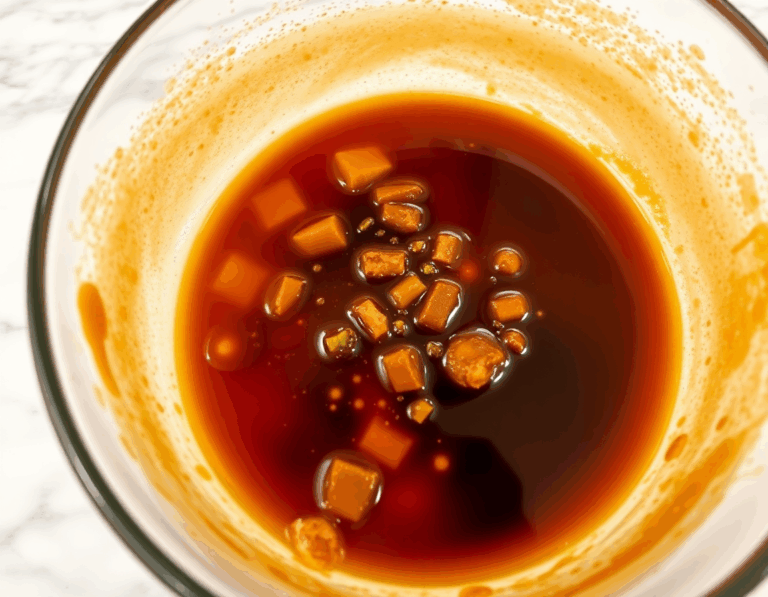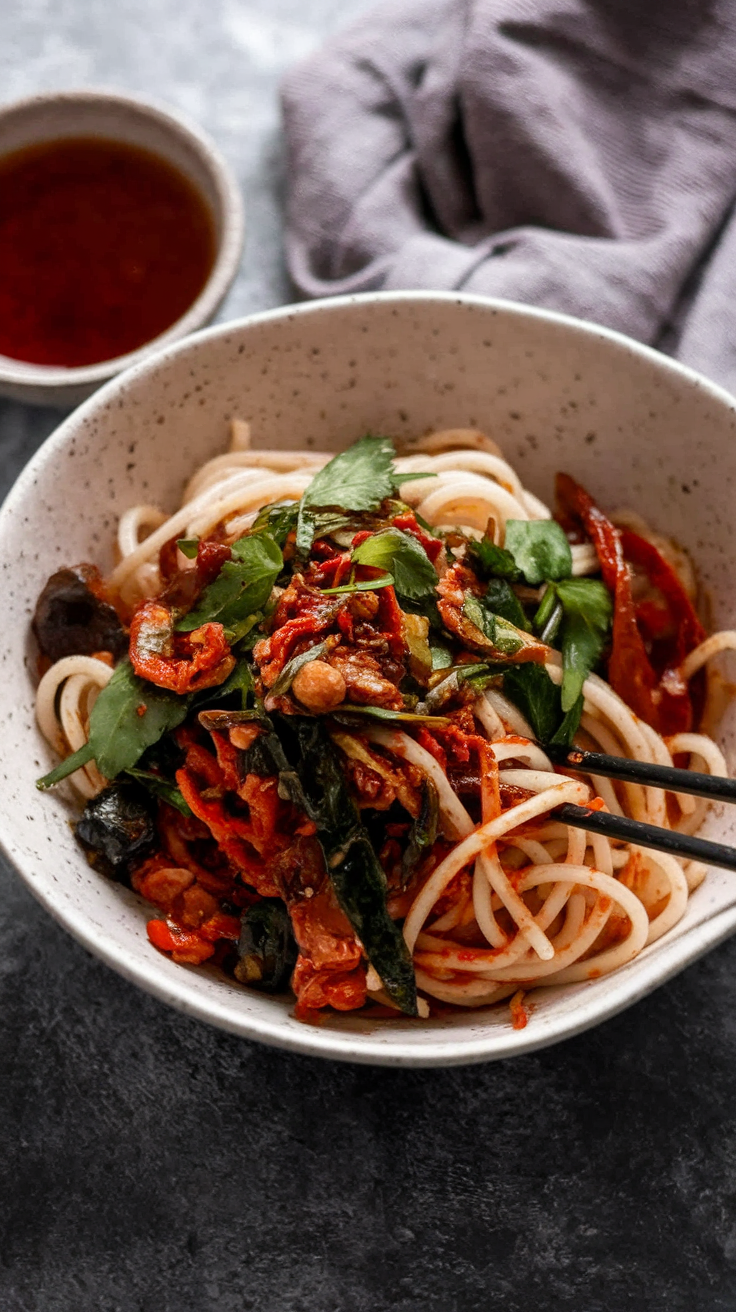If there’s one dish that brings me back to the bustling streets of Chengdu, it’s Dan Dan Noodles—fiery, aromatic, and oh-so-addictive. Imagine a bowl swirling with silky noodles, drenched in a vibrant, spicy sauce that tingles your taste buds, much like that unexpected pop concert I stumbled upon last summer. Cooking this dish might just transport you to a world where flavors dance as wildly as a TikTok trend—it’s an experience you won’t want to miss!
Steps
- Begin by preparing the Dan Dan sauce. In a bowl, combine all the sauce ingredients except the oil and chicken stock. Gently stir in the oil and hot chicken stock, ensuring the oil remains on the surface, then set aside.
- For the pork topping, mix hoisin sauce, soy sauce, Chinese wine, and five spice in a small bowl. Heat oil in a skillet over high heat, add the pork, and cook while breaking it up until it turns from pink to white. Stir in the sauce mixture and cook for another minute before transferring to a bowl.
- Warm the preserved mustard greens by adding oil to the same skillet over medium heat, followed by the greens. Stir them for about 30 seconds to heat through and set aside.
- Cook the noodles according to the packet instructions in a large pot of boiling water. Add the choi sum to the pot during the last minute of cooking, then drain both together.
- To assemble, ladle a portion of the Dan Dan sauce into a serving bowl. Layer the cooked noodles on top, followed by the pork, preserved mustard greens, and choi sum. Sprinkle with chopped peanuts and green onions.
- Before eating, mix everything in the bowl thoroughly so the noodles absorb the sauce and take on its spicy, flavorful coating. Enjoy the dish while it’s still warm.

Ingredients
- 2 tablespoons Chinese sesame paste (substitute with tahini)
- 1.5 tablespoons Chinese chili paste in oil
- 4 tablespoons light soy sauce
- 2 garlic cloves, minced
- 3 teaspoons white sugar
- 1/2 teaspoon Chinese five spice powder
- 1 teaspoon Sichuan pepper powder, preferably freshly ground
- 3 tablespoons (or more) chili oil, preferably Chinese
- 3/4 cup (185 ml) hot, low-sodium chicken broth/stock
- 2 teaspoons hoisin sauce
- 1 teaspoon dark soy sauce
- 1 tablespoon Chinese cooking wine (or 2 tablespoons extra chicken stock)
- 1/2 teaspoon Chinese five spice powder
- 1 tablespoon vegetable oil
- 250 grams (8 oz) pork mince (ground pork)
- 1 teaspoon vegetable oil
- 30 grams (1/4 cup) Sui Mi Ya Cai, finely chopped
- 500 grams (1 lb) white fresh noodles, medium thickness
- 16 choy sum stems, cut into 15 cm pieces
- 2 green onions, finely sliced
- 1 tablespoon peanuts, finely chopped (optional)
Nutritional Values
Calories: 2416cal | Carbohydrates: 224g | Protein: 84g | Fat: 136g | Saturated Fat: 40g | Cholesterol: 164mg | Sodium: 5456mg | Potassium: 1332mg | Fiber: 8g | Sugar: 20g | Vitamin A: 1840IU | Vitamin C: 32mg | Calcium: 192mg | Iron: 8mg
FAQ
- What are Dan Dan Noodles?
- Dan Dan Noodles are a popular spicy Sichuan noodle dish featuring slippery noodles tossed in a rich sesame sauce and topped with pork. The dish is known for its bold flavors and is traditionally layered for a DIY toss before eating.
- What ingredients are essential for Dan Dan Noodles?
- Key ingredients include Chinese sesame paste, Sichuan pepper, chili oil, Chinese chili paste, and chicken broth for the sauce. Toppings usually consist of stir-fried pork and pickled mustard greens. Medium-thickness white noodles and Chinese greens like choi sum are used to complete the dish.
- Can I make substitutions for certain ingredients?
- Yes, several substitutions are possible. Tahini can replace Chinese sesame paste, white pepper can be used instead of Sichuan pepper, and sriracha mixed with oil can substitute chili oil. Kimchi can replace the preserved mustard greens (Sui Mi Ya Cai).
- How spicy are Dan Dan Noodles?
- The recipe provides a moderate level of spiciness that is not overwhelming, suitable for those who enjoy a kick but don’t want extreme heat. Adjustments can be made by reducing the amount of chili paste and Sichuan pepper.
- What type of noodles should I use?
- Fresh, medium-thickness white noodles are recommended for the best contrast with the red chili oil. However, any type of wheat noodles can be used if fresh noodles are unavailable.
Tips
- Customize the Spiciness: Adjust the spiciness by varying the amounts of chili paste, Sichuan pepper, and chili oil. If you prefer a milder dish, start with less and add more to taste.
- Choose the Right Noodles: Use medium-thickness, white Asian wheat noodles for the best contrast against the spicy sauce. Fresh noodles are preferred, but dried noodles can work as well.
- Substitute Ingredients Thoughtfully: If you can’t find specific ingredients like Sui Mi Ya Cai, you can substitute with finely chopped kimchi. For Chinese sesame paste, use tahini with a dash of toasted sesame oil.
- Efficient Cooking: Cook the noodles and blanch the choi sum in the same pot to save time and reduce cleanup. Remember to cook the noodles just before serving so they remain hot for mixing with the sauce and toppings.
Equipment
- Spice Grinder – For grinding Sichuan pepper if you choose to buy whole peppercorns instead of pre-ground.
- Wok or Large Skillet – For stir-frying the pork and preserved mustard greens.
- Noodle Pot – A large pot for boiling noodles and blanching greens.
- Mixing Bowls – For preparing the sauce and other components.
- Measuring Spoons and Cups – For accurate measurement of ingredients.
- Fine Mesh Strainer – Useful for draining noodles and greens.
